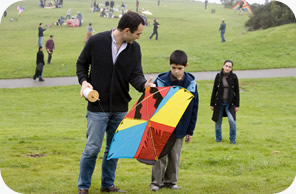Interpretations of the text
 Your work on genre will have raised a number of issues as to just what type
of film 'The Kite Runner' is.
Your work on genre will have raised a number of issues as to just what type
of film 'The Kite Runner' is.
One of the genres that we mentioned was the political film. One aspect of the film has to do with terrorism and the consequences of terrorist acts.
There is obviously a very timely link here between what we see happening in the film and the current 'war against terrorism'.
At one point during the film we see Amir reading Hassan's letter and hoping that:
'…one day his son will return to the land of their childhood’.
What needs to happen in Afghanistan in order for the '…land of their childhood' to be restored?
During the course of the film we see several changes in power as Soviet forces roll in to Afghanistan through to the time the Taliban takes control. The relationship to these authorities is shown through the eyes of Baba and Amir.
The political relationship between the US and Afghanistan has changed as we see when Baba is joined by Americans in a toast against the Russians. We also see that as a refugee from the Soviet invasion of Afghanistan, Amir and his father are welcomed to the United States.
The changing global politics has seen America supporting (financially and with military equipment) both Saddam Hussein (in his war against Iran) and also Osama bin Laden and Al Qaeda in their war against the Soviet Union. At that point they were considered 'freedom fighters'.
- What then turned them into 'terrorists'?
- Did they lose the support of their own people?
- Or did they go against what America wanted?
Looking at these moral dilemmas we should now think about what conclusions are offered by 'The Kite Runner'. Whose 'side' do you think the story comes down on?
What moral standpoint is taken in 'The Kite Runner'? And do you agree with it?
Structures